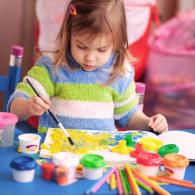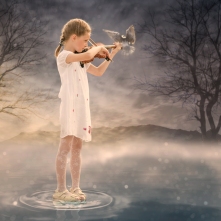Art lessons at public Kazakhstan schools are usually held till seven-eight grades. Absence of them in higher forms is easily explained by overloading of Math, which is considered to be one of the most important subjects on UNT. However, being in primary and secondary school, children have an art lesson only once a week, which may be not sufficient for their development.
First of all, arts are better taught in childhood because children’s brain as distinct from adults’ is not bound “by established solutions to challenges” (Sylwester, 2010, p. 131) and that is why is more open for creativity (Sousa, 2009). Secondly, in order to enable their creative thinking from a very beginning children need to be involved “in alternate reality of arts” (Sylwester, 2010, p. 151). Finally, self-expression, provided by involving in making arts, assists a child to cognize world and him/herself (Potebnya, 1976).
Watching a child who is sitting at the table and drawing a giraffe with gusto and pleasure it is easy to understand why he/she is so open for creativity. This process has totally “swallowed” him/her up and now a child is in his bright cloud-cuckoo-land, not afraid of being mistaken with chosen paint. He is enjoying “now”. Becoming adults, most of us lose the childish spontaneity and think all the time how others will evaluate our work. Maybe, overestimating the meaning of a result, we forget about a process even in creating arts.
There are a plenty am ount of studies, researching the importance and relevance of art for children’s development. Trying to find any correlation to their academic achievement, authors claim and prove that art lessons are crucial or vice versa that they are not so helpful and consequently don’t fit the curriculum. Regardless of the results, such evidence leads to misunderstanding of the role of art itself (Eisner, 1998). Never asking “does language proficiency help your child in painting?” we, nevertheless, continue to find influence of art lessons on academic achievement.
ount of studies, researching the importance and relevance of art for children’s development. Trying to find any correlation to their academic achievement, authors claim and prove that art lessons are crucial or vice versa that they are not so helpful and consequently don’t fit the curriculum. Regardless of the results, such evidence leads to misunderstanding of the role of art itself (Eisner, 1998). Never asking “does language proficiency help your child in painting?” we, nevertheless, continue to find influence of art lessons on academic achievement.
Art lessons can do more than this: to foster children’s aesthetic and cognitive skills; that is why they are worth to be placed in a curriculum more than once a week. To deduce, as Maria Montessori may say, this practice will provide a child with understanding that he/she “is not the son of a man, but the creator and father of man” (Martin, Jane, 2001).
References
Eisner, E. W. (1998). Does experience in the arts boost academic achievement?. Arts Education Policy Review, 100(1), 32-40.
Potebnya, A. A. (1976). Aesthetics and poetics, Moscow.
Martin, Jane R. (2001) Maria Montessori. In: A. Palmer, Fifty Major Thinkers on Education. London: Routledge, 224-228.
Sousa, D. A. (Ed.). (2009). How the gifted brain learns. Corwin Press.
Sylwester, R. (2010). A Child’s Brain: The Need for Nurture. Corwin Press.
Thank you for bringing up this topic, @katerinajupiter. I totally agree with this post and support the idea of offering a variety of art classes in schools: singing, painting, playing on musical instruments. This would develop creativity, critical thinking, enhance their brain activity and so forth. I believe that our country would have much more famous artists in this case. Unfortunately, most of our children are deprived of chance to try themselves in art, because their high workload does not leave any time it. Hope, this situation will change soon.
LikeLiked by 1 person
Dear Katerina,
I enjoyed reading your post! I agree with you that art lessons foster creativity and form children’s unique individuality. Alas, today parents are more likely to ignore this activity, preferring instead to give their offspring to more ‘serious’ subjects as tutoring in math or English. The possible reason could be that parents usually do not consider singer, photographer, painter, whatever connected with art as a profession. I think that parents should change their position. First, some of art lessons (as drawing, for example) could expose children’s psychological condition. In other words, if a child has some worries or problems, he or she can vent them in drawings with dark colors or frightful drawings. Secondly, taking children away from art, perhaps, we lose second Bach or Botticelli? Who knows?
LikeLiked by 1 person